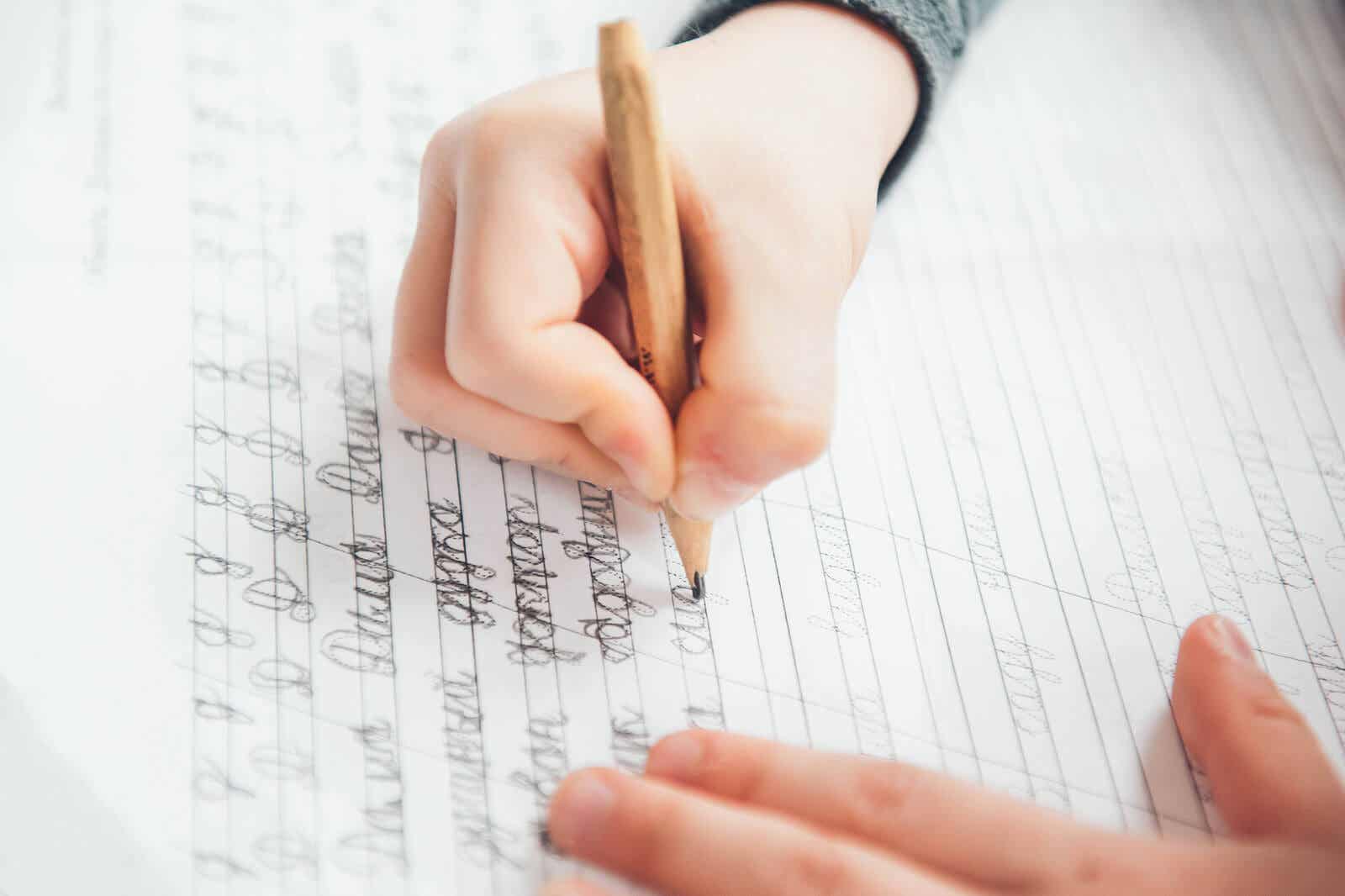Pre-writing Activities to Do at Home

There are some beneficial pre-writing activities to help children develop these skills that you can do at home. You need to keep these activities in mind because they’ll do your children a lot of good for their overall improvement.
So, below, we’re going to give you some ideas of pre-writing activities to do with preschoolers to make sure they go through the right stages until formal writing.
Gross Motor Activities in Writing
Gross motor skills begin to form when a child is born and should continue to develop well into school age. Therefore, little ones should play for a long time each day.
This is the best way to develop gross motor skills. Sports and other adult-guided activities are helpful, but they will still develop more motor skills through free play.
To learn to write, children need to have control of their bodies and develop gross motor skills. Fine motor control depends on having well-developed gross motor control.

They need to learn to cross the midline, e.g., write on the left side of the page with the right hand; develop bilateral integration, e.g., write with one hand and control the page with the other; finger strength, and eye-hand coordination, among other things.
Children should also have the correct posture when sitting at a desk; they should sit upright with their feet flat on the floor and their arms at right angles on the table.
When they slouch, tire, or struggle to sit and concentrate, they often have poorly developed gross motor control. In addition, they must move in a variety of ways: Running, jumping, balancing, jumping rope, kicking a ball, riding a bike…
Fine motor activities in writing
When a child’s developed their fine motor skills, they’ll be able to do the following:
- Write without getting tired
- Use the gripper well to hold the pencil
- Write correctly
Fine motor skills can be developed in several simple ways, mainly through play. In that sense, the following are some great pre-writing activities:
- Drawing and painting
- Cutting and tearing
- Doing puzzles
- Playing with blocks or pegs
- Sewing and threading
- Making patterns
Letter activities
Letters and numbers made of wood, foam, or plastic are a great way to introduce writing. Touching the letters, tracing them with their fingers, etc., shows letter formation (where to start and how to form them).
Formation patterns
When your child holds a pencil correctly and doesn’t get tired, they’re ready to begin the patterning stage. Using a rubber grip to hold the pencil will make a big difference, as their fingers will be resting in the correct position from an early age.
Pencil grip is another thing that’s extremely difficult to correct once an incorrect habit has been formed. To do this, take a large sheet of paper or use chalk on the floor outside, and make patterns like the following:
- Scribble in large circular motions, first to the left (as in the letter d), then to the right (as in the letter b).
- Doodle in zigzag motions, first up and down, then left to right.
- On the sand, for example, you can make other patterns, such as waves, straight lines, etc.
Then it’s time to move on to writing patterns on paper. Before you start, spend 5 minutes doing some finger strengthening exercises, such as moving, shaking, or crumbling a piece of paper with one hand.

Formal writing activities
When your child’s older, more mature, and has mastered pre-writing skills, they’ll be ready to learn to write formally. You don’t want to rush at this stage either. Introduce letters slowly and thoroughly before attempting to move on to proper writing activities.
Learning letters
When introducing letters, also follow the process from large to small. Here is a good procedure for each letter:
- Introduce a letter by listing some words that begin with it.
- Talk about the sound and find other words that have the same sound.
- Show the correct formation of the letter.
- Ask your child to write that letter on the table, on your back, or on the floor.
- Write the letter on paper in different colors.
There are some variations in the order in which the letters should be introduced, but here’s a rough guide. It’s best to start with the letters s, a, t, i, p, n, as it is agreed that these are the ones that make up a good number of 3-letter words when you start reading. The order, therefore, would be s, a, t, i, p, n, m, r, c, d, q, o, e, f, l, h, b, k, j, y, u, w, v, x, z.
Finally, when your child’s mastered writing or is beginning to master it, a great formal writing idea is to write a letter to a loved one to send by snail mail – they’ll be so excited!
We hope you’ll try these pre-writing activities with your children to help them through this important process in their lives while you have a wonderful time together. What are you waiting for to get started?
There are some beneficial pre-writing activities to help children develop these skills that you can do at home. You need to keep these activities in mind because they’ll do your children a lot of good for their overall improvement.
So, below, we’re going to give you some ideas of pre-writing activities to do with preschoolers to make sure they go through the right stages until formal writing.
Gross Motor Activities in Writing
Gross motor skills begin to form when a child is born and should continue to develop well into school age. Therefore, little ones should play for a long time each day.
This is the best way to develop gross motor skills. Sports and other adult-guided activities are helpful, but they will still develop more motor skills through free play.
To learn to write, children need to have control of their bodies and develop gross motor skills. Fine motor control depends on having well-developed gross motor control.

They need to learn to cross the midline, e.g., write on the left side of the page with the right hand; develop bilateral integration, e.g., write with one hand and control the page with the other; finger strength, and eye-hand coordination, among other things.
Children should also have the correct posture when sitting at a desk; they should sit upright with their feet flat on the floor and their arms at right angles on the table.
When they slouch, tire, or struggle to sit and concentrate, they often have poorly developed gross motor control. In addition, they must move in a variety of ways: Running, jumping, balancing, jumping rope, kicking a ball, riding a bike…
Fine motor activities in writing
When a child’s developed their fine motor skills, they’ll be able to do the following:
- Write without getting tired
- Use the gripper well to hold the pencil
- Write correctly
Fine motor skills can be developed in several simple ways, mainly through play. In that sense, the following are some great pre-writing activities:
- Drawing and painting
- Cutting and tearing
- Doing puzzles
- Playing with blocks or pegs
- Sewing and threading
- Making patterns
Letter activities
Letters and numbers made of wood, foam, or plastic are a great way to introduce writing. Touching the letters, tracing them with their fingers, etc., shows letter formation (where to start and how to form them).
Formation patterns
When your child holds a pencil correctly and doesn’t get tired, they’re ready to begin the patterning stage. Using a rubber grip to hold the pencil will make a big difference, as their fingers will be resting in the correct position from an early age.
Pencil grip is another thing that’s extremely difficult to correct once an incorrect habit has been formed. To do this, take a large sheet of paper or use chalk on the floor outside, and make patterns like the following:
- Scribble in large circular motions, first to the left (as in the letter d), then to the right (as in the letter b).
- Doodle in zigzag motions, first up and down, then left to right.
- On the sand, for example, you can make other patterns, such as waves, straight lines, etc.
Then it’s time to move on to writing patterns on paper. Before you start, spend 5 minutes doing some finger strengthening exercises, such as moving, shaking, or crumbling a piece of paper with one hand.

Formal writing activities
When your child’s older, more mature, and has mastered pre-writing skills, they’ll be ready to learn to write formally. You don’t want to rush at this stage either. Introduce letters slowly and thoroughly before attempting to move on to proper writing activities.
Learning letters
When introducing letters, also follow the process from large to small. Here is a good procedure for each letter:
- Introduce a letter by listing some words that begin with it.
- Talk about the sound and find other words that have the same sound.
- Show the correct formation of the letter.
- Ask your child to write that letter on the table, on your back, or on the floor.
- Write the letter on paper in different colors.
There are some variations in the order in which the letters should be introduced, but here’s a rough guide. It’s best to start with the letters s, a, t, i, p, n, as it is agreed that these are the ones that make up a good number of 3-letter words when you start reading. The order, therefore, would be s, a, t, i, p, n, m, r, c, d, q, o, e, f, l, h, b, k, j, y, u, w, v, x, z.
Finally, when your child’s mastered writing or is beginning to master it, a great formal writing idea is to write a letter to a loved one to send by snail mail – they’ll be so excited!
We hope you’ll try these pre-writing activities with your children to help them through this important process in their lives while you have a wonderful time together. What are you waiting for to get started?
All cited sources were thoroughly reviewed by our team to ensure their quality, reliability, currency, and validity. The bibliography of this article was considered reliable and of academic or scientific accuracy.
- Ballesteros Valdez, B. (2019) Aprender a escribir letras para niños. Editorial. El Alfabeto
This text is provided for informational purposes only and does not replace consultation with a professional. If in doubt, consult your specialist.








